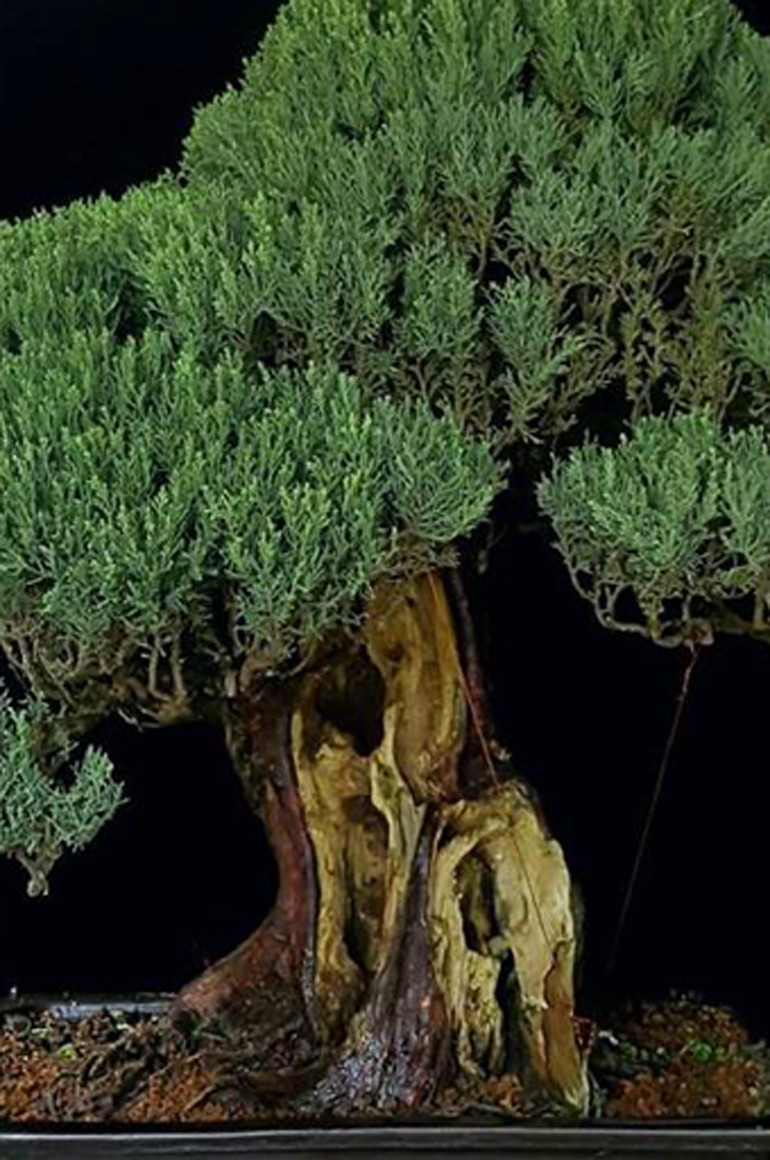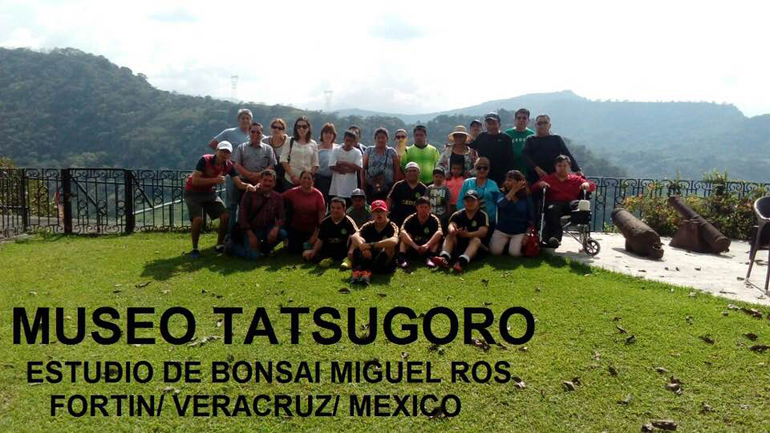Clip & Grow Bonsai – No Wire Necessary
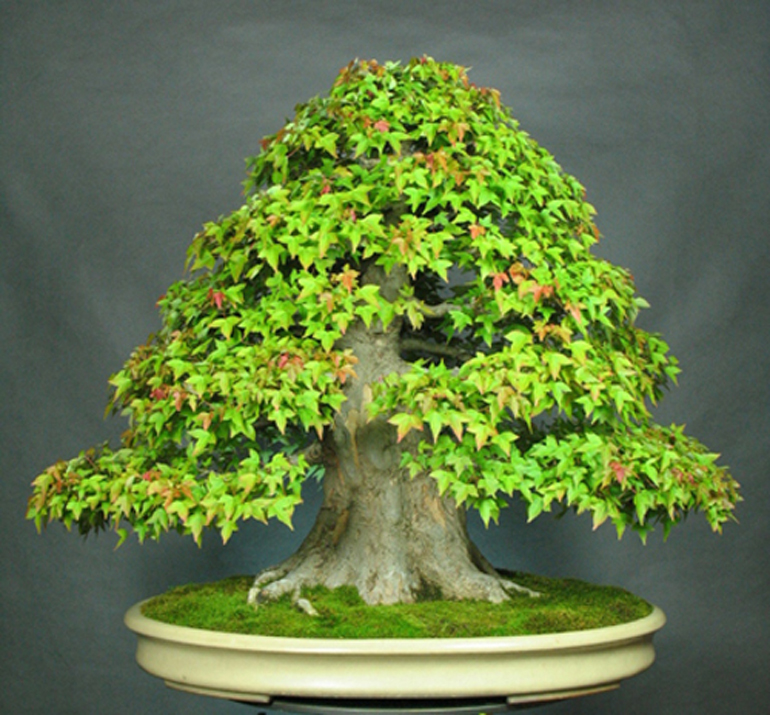
This massive Trident maple most likely started in a field somewhere and was allowed to grow quite tall (the fastest way to thicken the trunk) before it was cut back. This first cut was the beginning of clip and grow styling (see below). The owner/artist of this outstanding bonsai is German Gomez.
Most large Trident maples and many other deciduous trees are started in the field and developed using the clip and grow technique. The result is usually a heavy trunked tree with gentle curves, often in a more or less S shape. You can see this basic shape in the Trident maple in old field growing post here on Bark. A variation of this S curve also shows up in the pine that is shown in the same post, though it was created by other means (trimming and wiring), as pines and other conifers don’t usually take to the clip and grow technique.
One more day of vacation, so we’ve taken a shortcut. The photos and most of the text in this post originally appeared here in November, 2015
Continued below…
These simple illustrations of the clip and grow technique are from a website called The Bonsai Primer. The left image shows the first cut, the next one shows the second cut, and so forth.
There was a day before wiring became the norm, when most non -conifer bonsai were trained primarily by clip and grow. Some purists still eschew wire in allegiance to the old ways, but their numbers are dwindling; wiring just offers too many advantages.
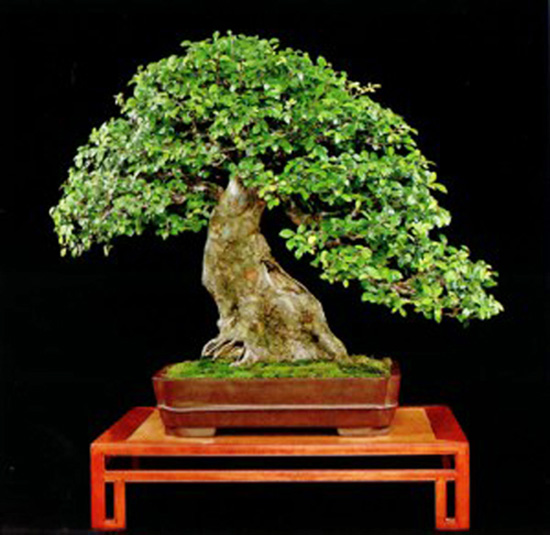
You can see the large scar from the first cut on this powerful old Chinese elm (Ulmus parviflora) . If you follow the trunk up a ways, you can see the change of direction where the second cut took place, though you can't see a scar from this view. This tree appears in the 1st U.S. National Bonsai Exhibition Album (out of print but 4 & 5 are still available). It was started from a large collected tree in China. The owner/artist is Melvyn Goldstein.
One more day of vacation, so we’ve taken a shortcut. This post originally appeared here in November, 2015
Bonsai Art & the Art of Bonsai
The day has barely started and I'm already running out of superlatives. I guess spectacular will do in this case. It's a Korean hornbeam (Carpinus turczaninowii) that belongs to Ian Stewartson. The photo is from Bonsai Art's website.
Delving into our archives, while sticking with our German theme (see yesterday). This one originally appeared March 2013.
Bonsai Art magazine is very well named. As bonsai magazines go, it’s as beautiful and professional as they come. The problem, for most of us at least, is that it’s in German. But really, the photos and overall presentation are so good that maybe the language isn’t as important as you might think.
Here's another kusamono (see yesterday), which is Japanese for companion plantings, or herbaceous plants in bonsai containers when they stand alone. This Thalictrum (Meadow-rue), also from Bonsai Art's website, belongs to Wolfgang Putz.
–
Okay, the trunk is massive for sure, but there's more to this tree (ramification and taper come to mind). It's another Korean hornbeam (Carpinus turczaninowii). This one belongs to Mariusz Komsta and the photo like the others shown here is from Bonsai Art's website. The smaller bonsai looks like a Shimpaku.
Learning from the Master, Masahiko Kimura. This is a pretty good example of what a spread in Bonsai Art looks like.
Bonsai Art's cover. The tree, a Scots pine (Pinus sylvestris), won a special prize at the 2013 Noelander's Exhibition. It resides at the Bonsai Museum in Dusseldorf. The artist is David Benavente.
A Bonsai First
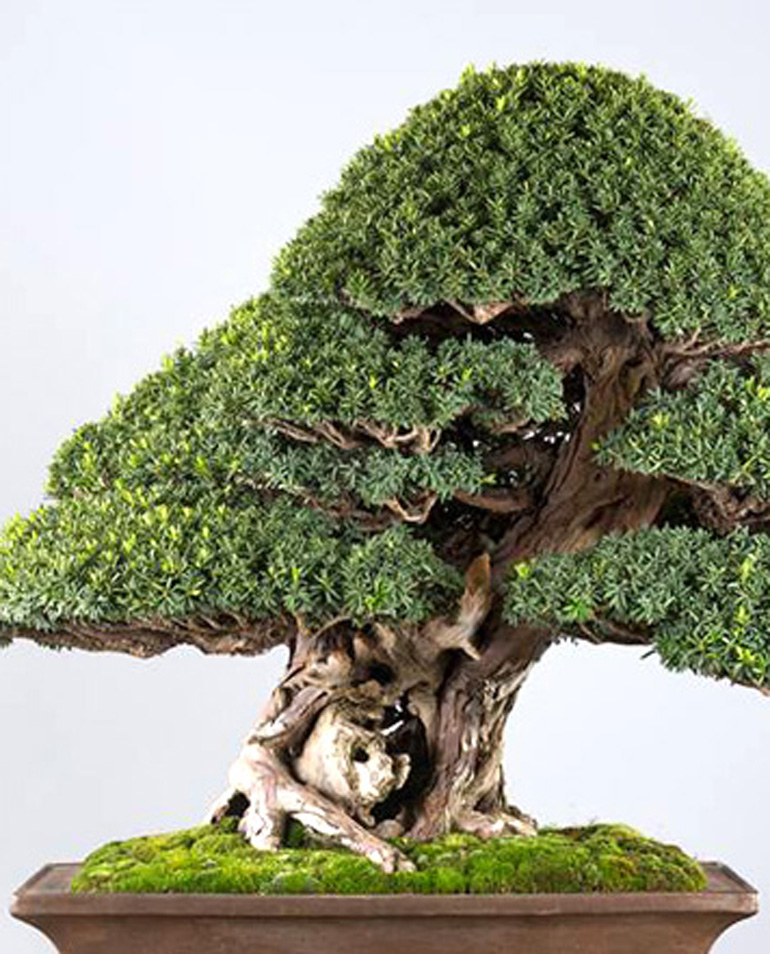
I took the liberty of cropping this photo to better appreciate its strikingly powerful and expressive trunk. The tree is a Japanese yew (Taxus cuspidata) that belongs to Heinrich Hacker. The original photo is below.
Today’s photos are all from Bonsai-Club Deutschland. If memory serves (a 50-50 proposition at best) it’s a first for us. Anyway, I’m very impressed and imagine that you too will be impressed.
–
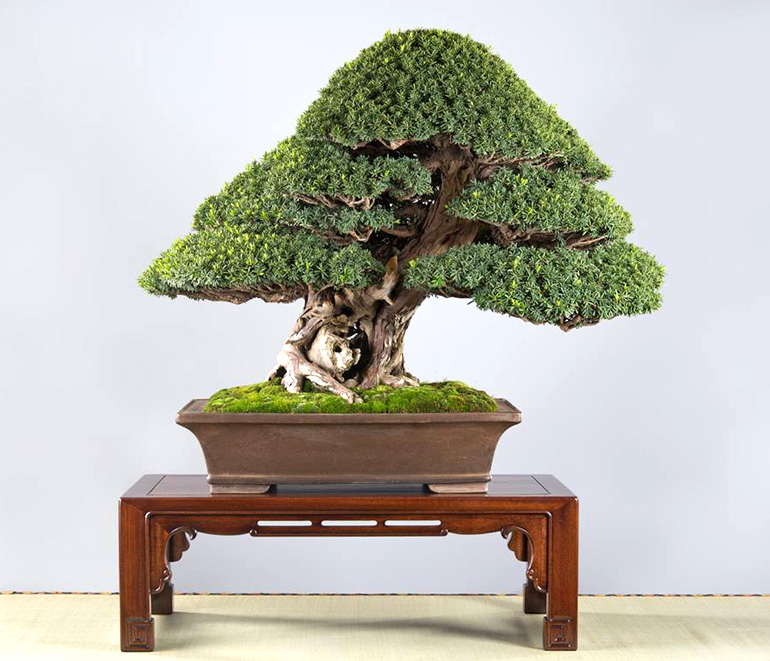
The whole tree in all its splendor. In addition to its aforementioned trunk you might notice how dense the canopy is. BTW, its size is listed as Oomono, which means large in Japanese
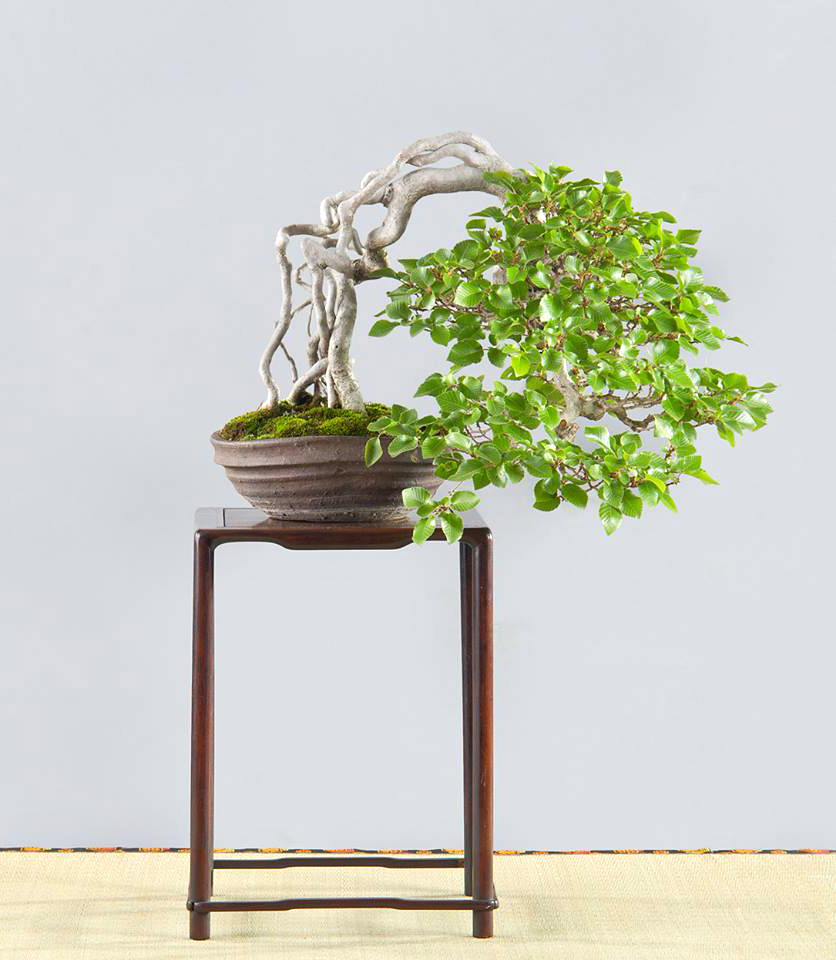
This cascading beauty with it's artistic, elegant trunk is a Korean hornbeam (Carpinus turczaninowii). It belongs to Ivo Drüge. The size is listed as Chuhin (medium to large)
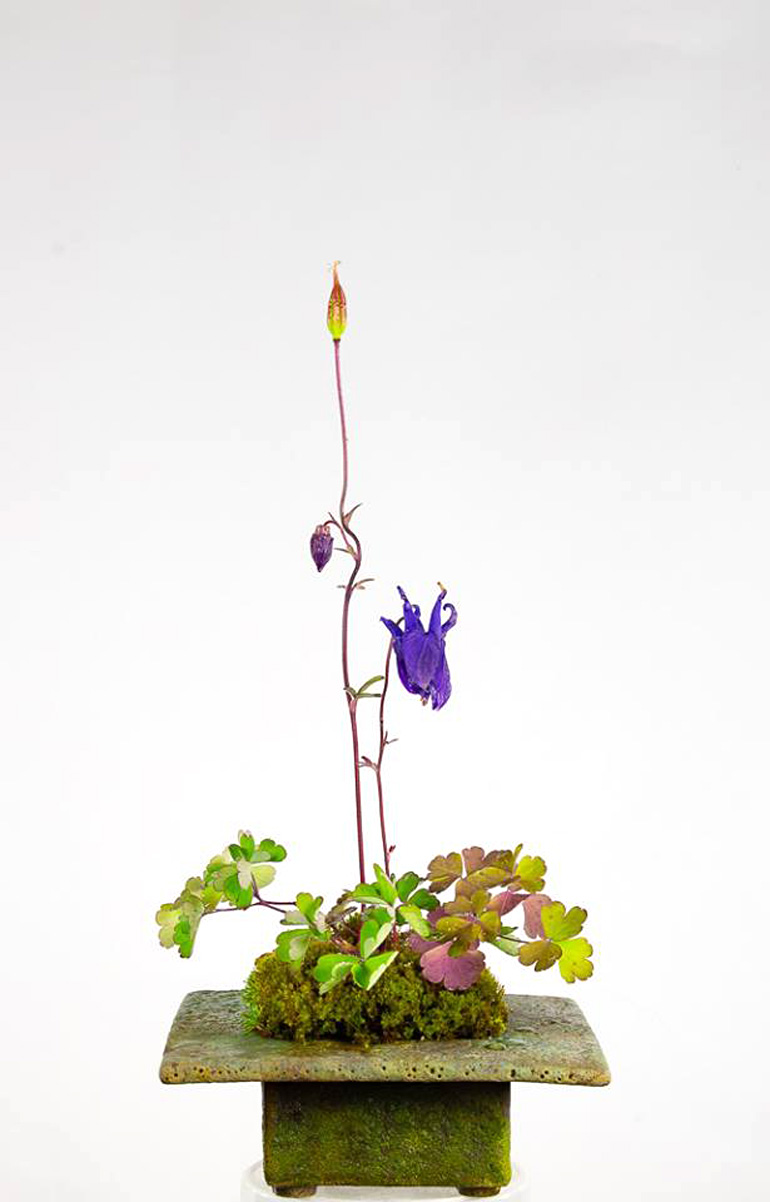
Simple beauty in an exceptional pot. This could serve as a companion to a bonsai (it would have to be a very good one) or stand on its own. It's a Aquilegia that belongs to Jean-Pierre Reitz. The pot is listed as Carlos Hebeisen-Takahama
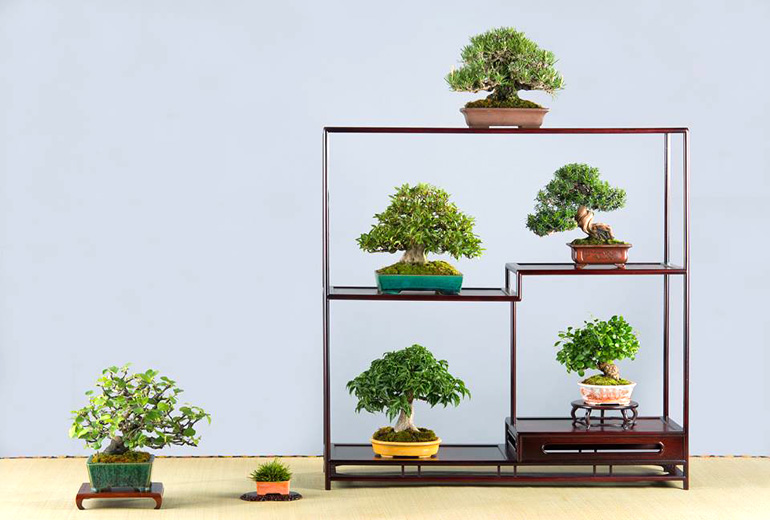
Shohin display by Peter Schwarzer. No varieties are listed
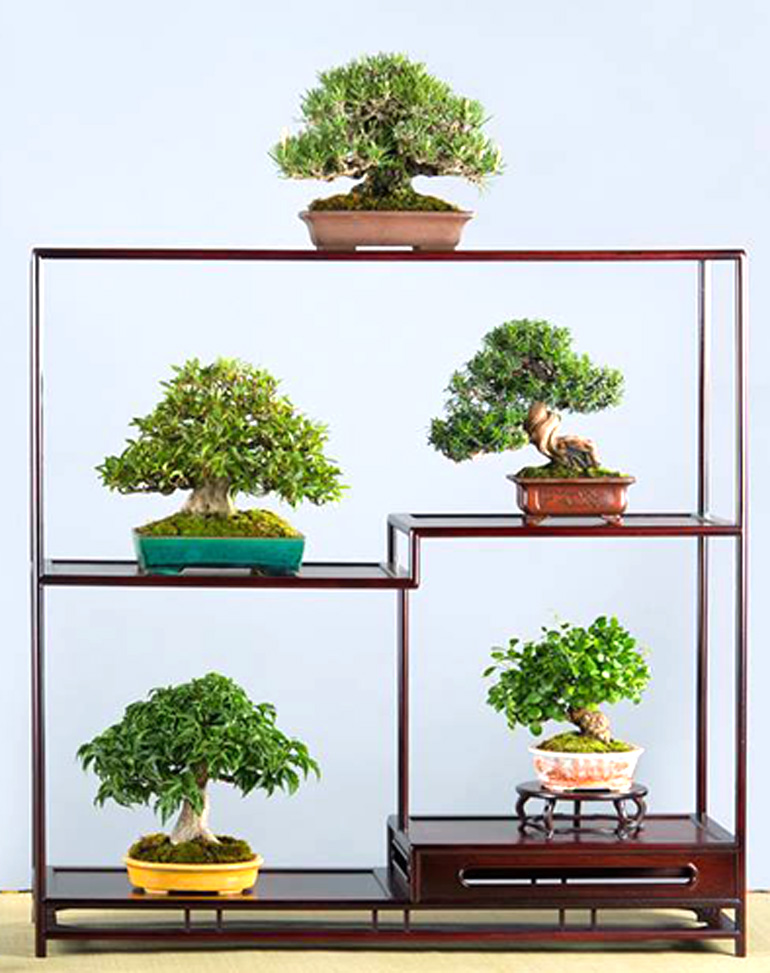
Close up of part of Peter's display. Any of these trees could stand on its own
Michael Hagedorn’s Review of Bonsai Empire’s Advanced Course
Bjorn Bjorholm, course instructor and highly respected bonsai artist and teacher, busy doing something he enjoys
In Michael’s own words…
“Once more we have an educational video from Bonsai Empire, using the talents of Bjorn Bjorholm. This is the longest of the three courses so far from the team of Bjorn and Bonsai Empire, running a full 6 hours.
“This is a good and helpful course. The strengths of the Advanced Course are its simplicity of presentation, Bjorn’s extensive and communicable knowledge, the written key points at the end of each section, and most especially the ‘Case Studies’ which cover specific topics on one tree in depth. I thought those in particular were well done, and I think that Bjorn’s presentation style is more conversational in the Case Studies as well.”

“Fans of conifers will be satisfied, fans of deciduous will be satisfied; both are covered equally.”
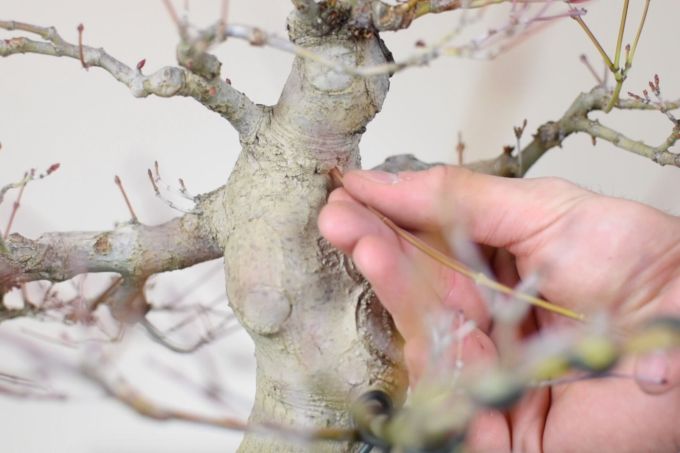
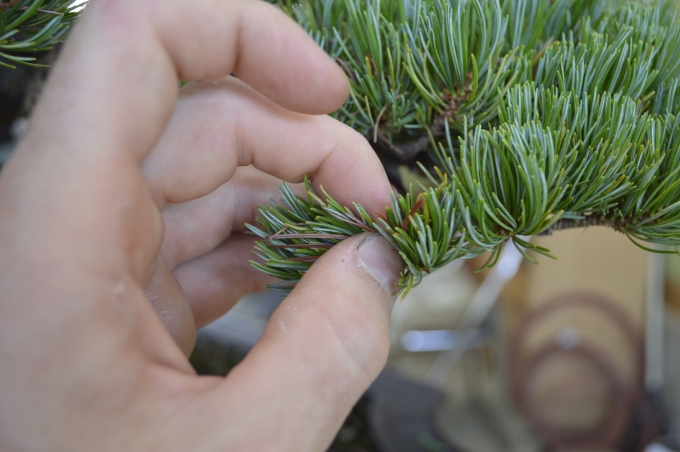
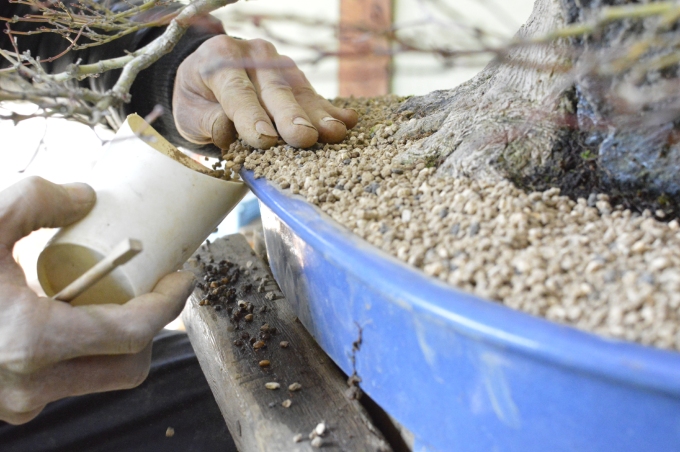
Michael continued from above…
“If I had to critique the course in any way I think the sections on ‘Environment’ and ‘Culture’ may seem a bit long for their points of utility to some people, as good as they are. I personally found them quite engaging and well done. It’s not easy to cater to all tastes and interests, and this section will appeal most to those already curious about history and culture. For those who prefer applicable ‘nuts and bolts’ tutorials, they will find that given the length of this course there is still tons of that kind of info.”
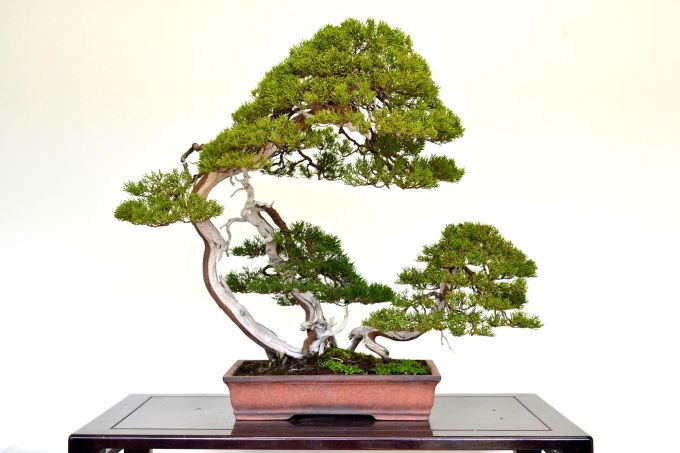
“Aesthetically this course is simply gorgeous. The attention paid to a full range of images including slow mode, speeded up clips, and overhead views (I assume they did not rent helicopters) enliven this course beyond any of its predecessors.
“The Advanced Course is a very solid showing of Bjorn’s, with Oscar’s usual clean packaging job which continues to get better with each installment. Those seeking to apply advanced bonsai techniques will benefit from seeing it done in a careful and clear manner, as presented in the Case Studies. In all I think this latest course is a very useful tool for bonsai enthusiasts and is a continuation of an excellent series that—given its video format and solid instruction—is second only to a live teacher.
For more about the Advanced Course including questions, please go to Bonsai Empire.”
Satsuki Flowers, Maple Leaves, a Tiny Lizard & Other Bonsai Wonders
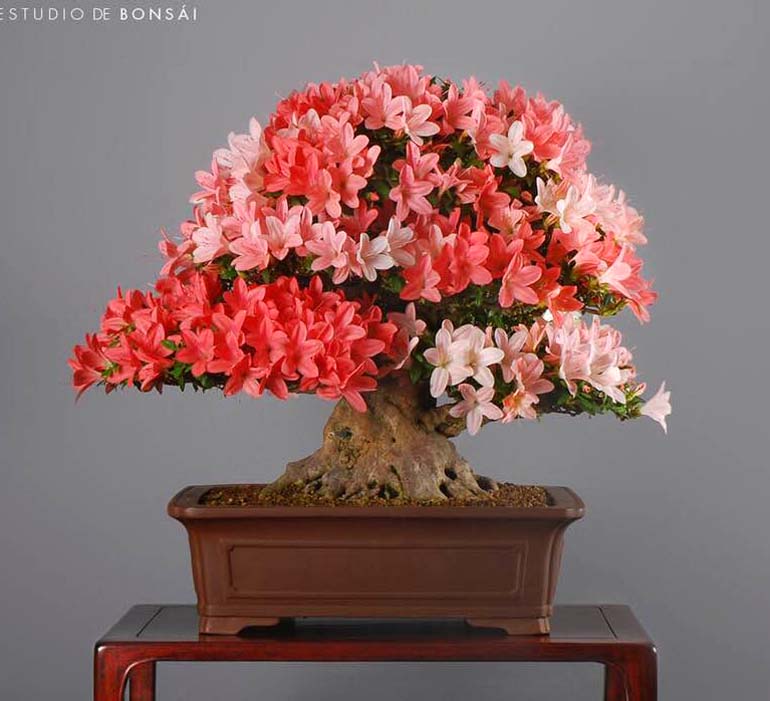
It's that time of year. Here's David Benavente's caption... Rhododendron indicum “Shin Nikko” hoy, en plena floración (today in full bloom). 45x55cm (18" x 21.5")
It’s been a while since we’ve featured David Benavente and his Estudio de Bonsái. It’s in Galapagar, Spain. Just outside of Madrid. The photos are from David’s timeline
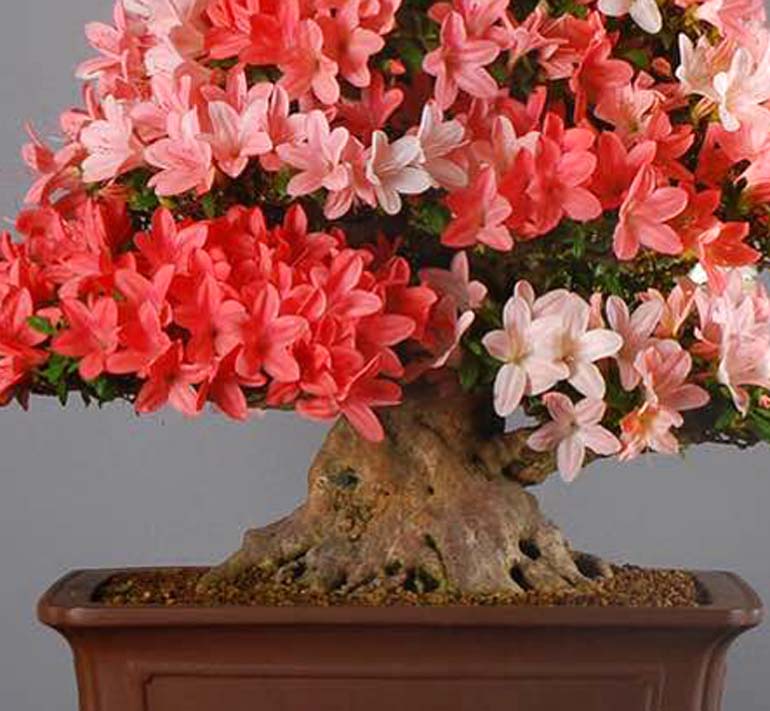
It's not only about the flowers. Close up of the lower trunk and nebari
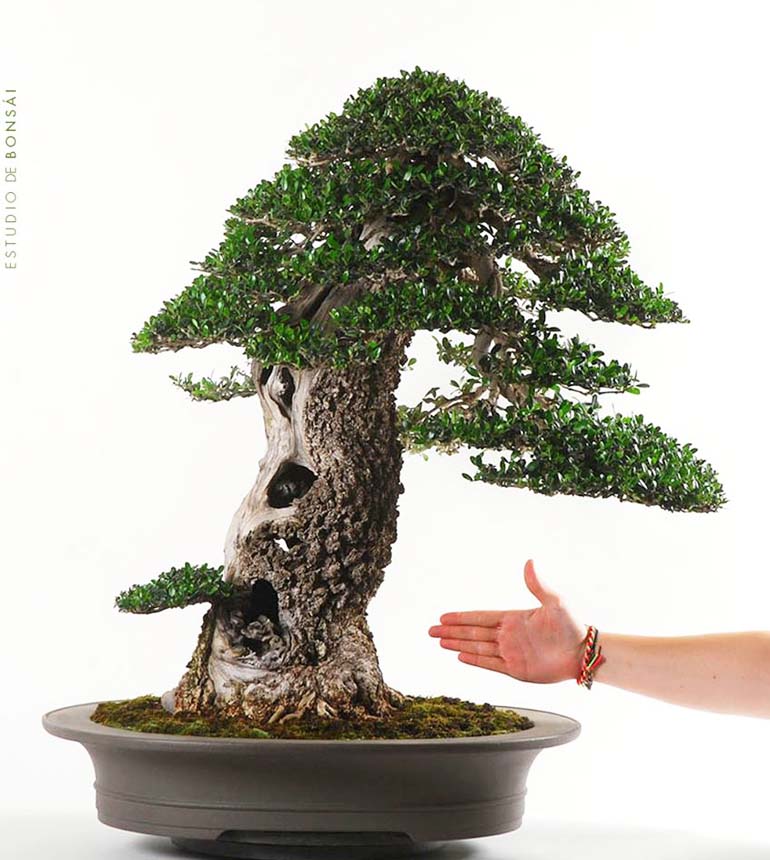
European olive (Olea europaea). No caption with this one, but it speaks for itself

Closeup
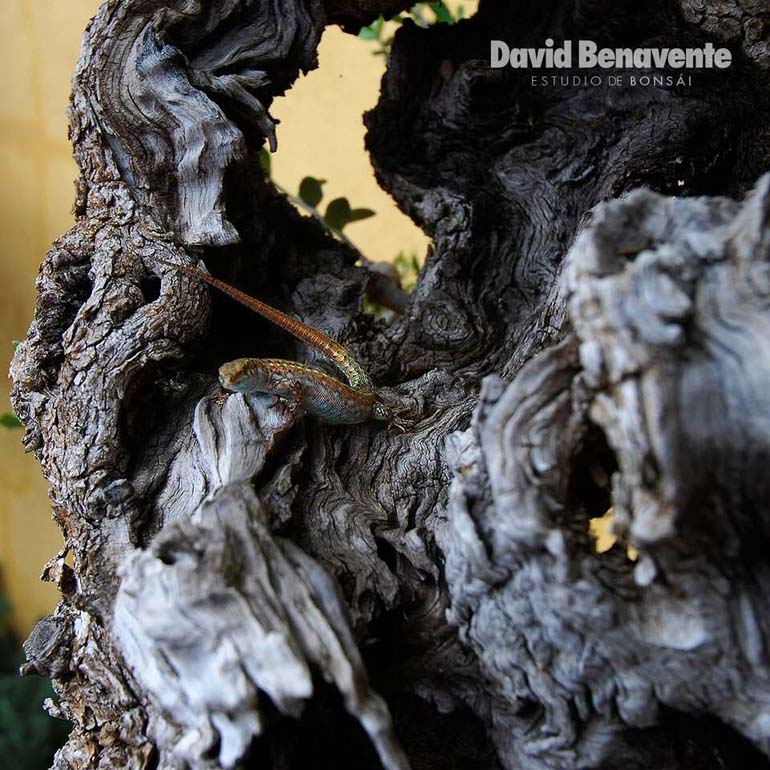
Lizard on a European olive. Is this the same tree?
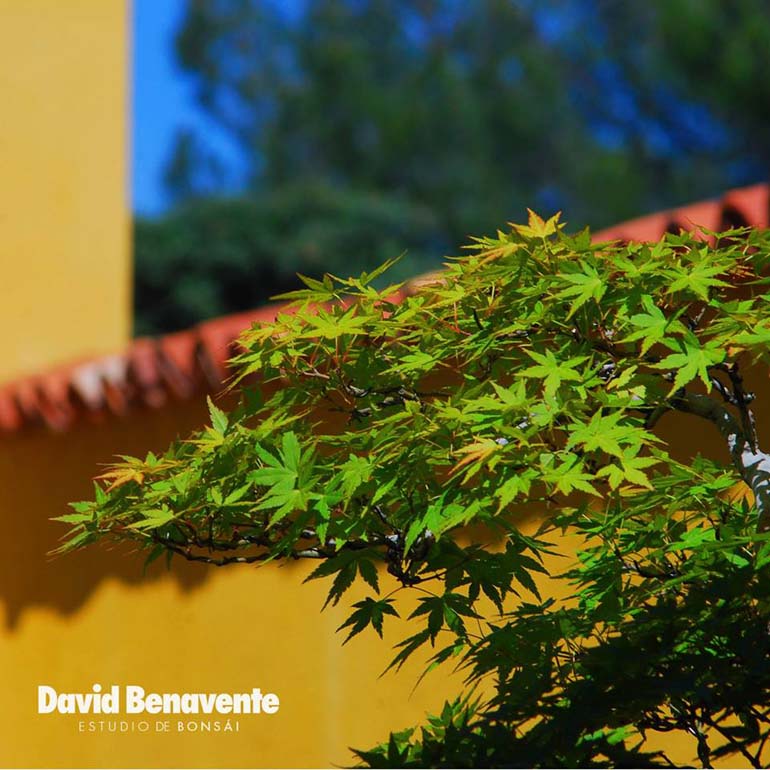
Japanese maple leaves
Unique Tropical Bonsai – Tool Special Ends Soon
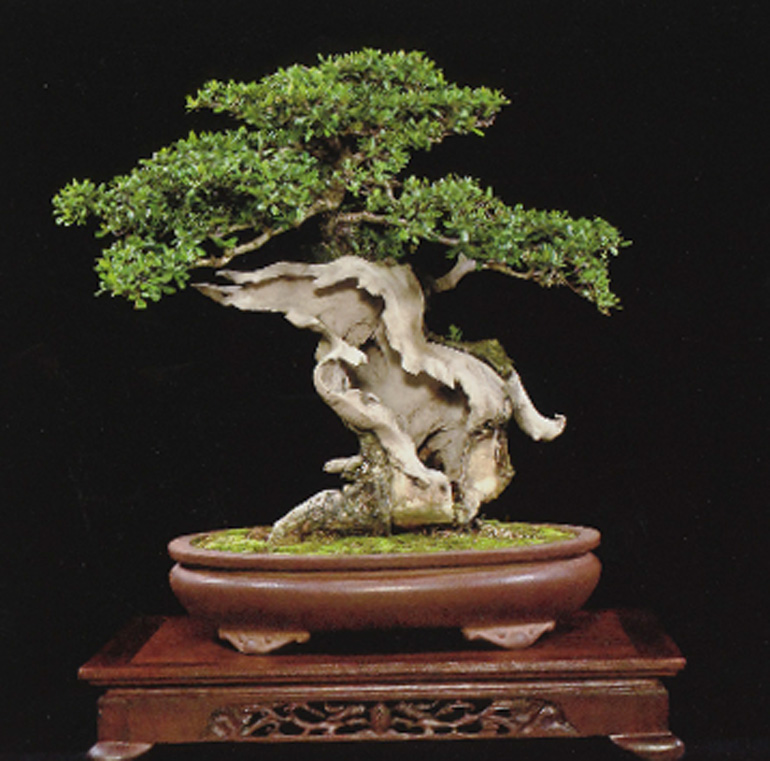
This tropical Dwarf black olive (Bucida spinosa, not a true Olive or Olea) with its melted wax feel and gaping trunk is a unique tree that only Mother Nature and Mary Madison's skilled hands could create. It's from the 2008, 1st U.S. National Bonsai Exhibition album.
If the pot was better suited to the tree (or a least cleaned up) and the background was better, the rugged power and reach of this tree would easier to appreciate. Still, if you're looking for unique bonsai, this wouldn't be a bad place to start. Like the tree above it's a Bucida spinosa. I found it at Komunitas Seniman Bonsai Indonesia
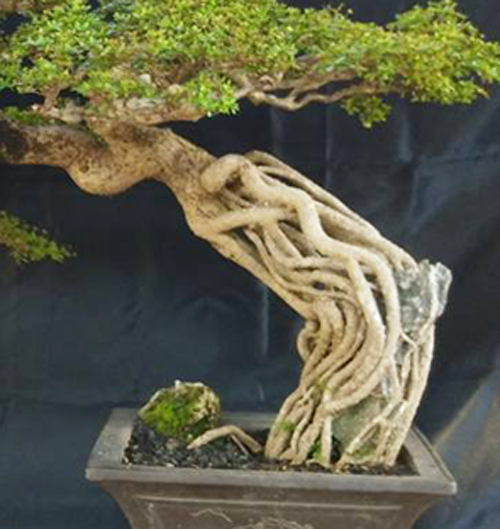
The other side, close up. Root over rock. Or maybe rock swallowed by the exposed root trunk would be more descriptive.
The Soul of a Tree
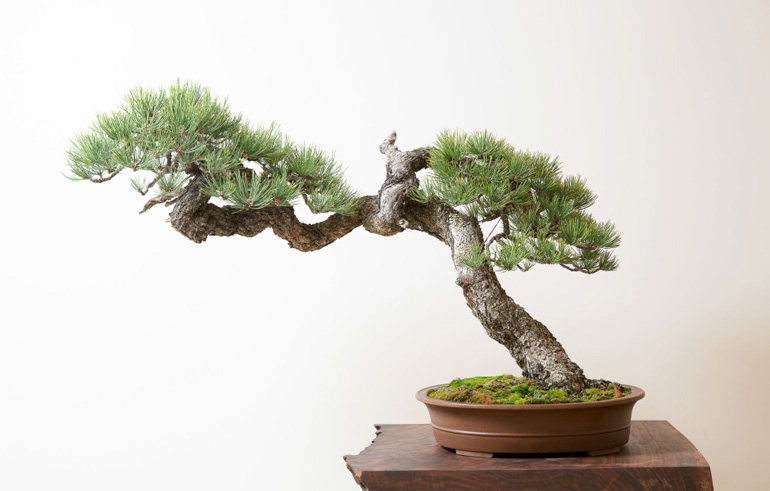
"In Japan, I'm sure they would say this is not bonsai and cut this very long branch off," says (Ryan) Neil. "But when I purchased this piece of material (Ponderosa pine), the only thing I could think is: man, how could you take this wild, undulating branch that — although it may sit outside of the dimensions of what the Japanese model says makes a bonsai — you cut that off and you lose the soul of the tree. So I think what makes the American style special is preserving the wildness and resisting the temptation to domesticate it." From Think out loud, Oregon Public Broadcasting.
Vacation time, so we’ll resort to our old tricks. This one originally appeared in May 2016.
There’s no doubt that Ryan Neil and his bonsai are trending. Here on Bonsai Bark and in this case in an article from Think out loud, an Oregon Public Broadcasting blog. In addition to the photos shown here, the article features a podcast of a discussion with Ryan that is a must for anyone interested in bonsai in general and specifically American bonsai.
Continued below…
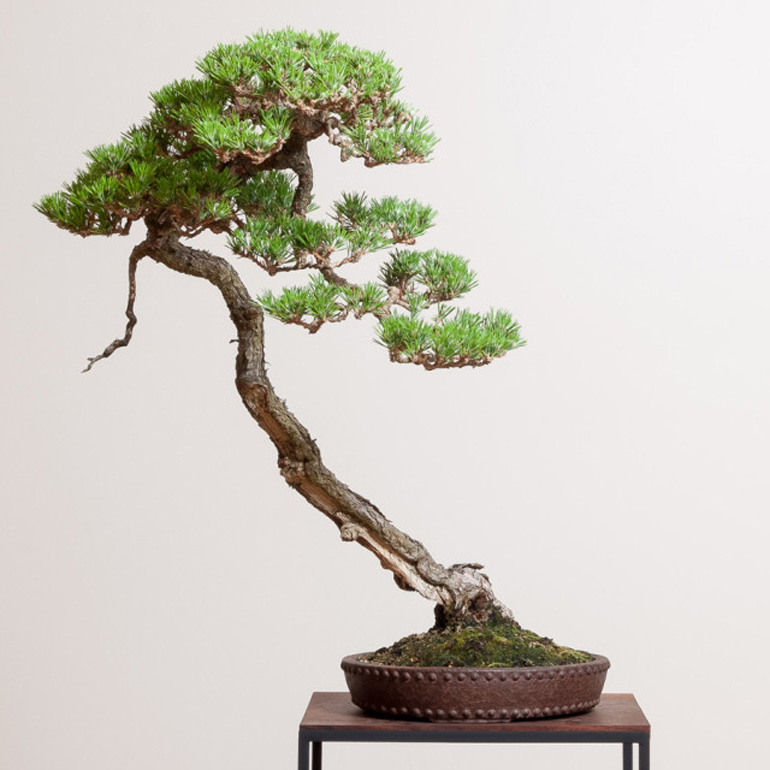
The caption with this exquisite Bunjin Japanese black pine reads "The goal of Bonsai Mirai and the Artisans Cup at the Portland Art Museum: to update bonsai for a new, distinctly American generation."
Continued from above…
Here’s a quote from the Think Our Loud blog: “Ryan Neil is an American bonsai master. He explains how the ancient Japanese art form translates to U.S. style, and walks us through an exhibit of his work currently (this was May, 2016) up at the Portland Japanese Garden.”
For more on Ryan and his bonsai, you can visit his Bonsai Mirai. You might also take a look at any of the numerous Bonsai Bark posts that feature Ryan’s trees and the Artisans Cup.
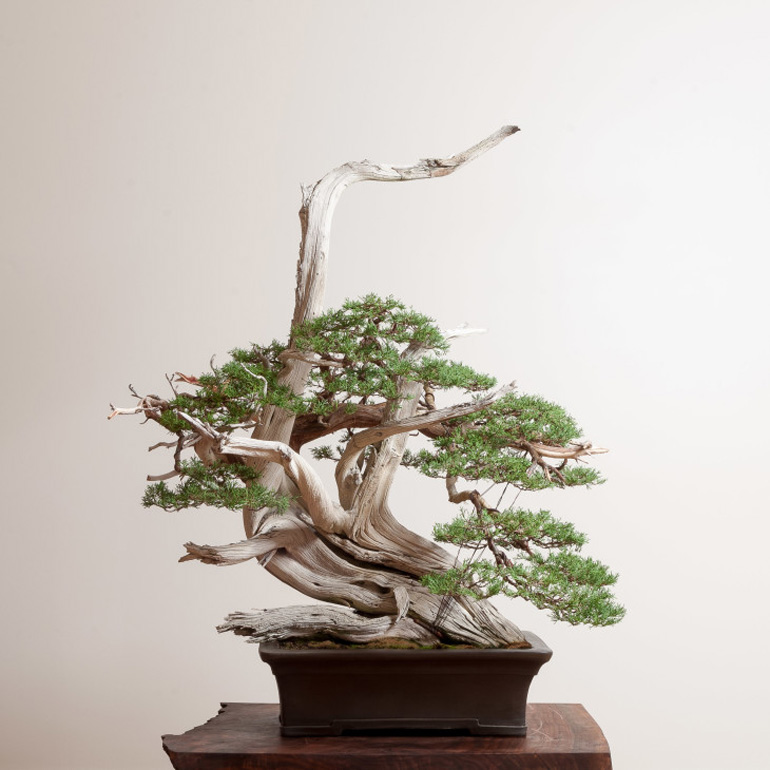
Big rugged deadwood dominated Rocky mountain junipers are often front and center wherever Ryan's bonsai are featured.
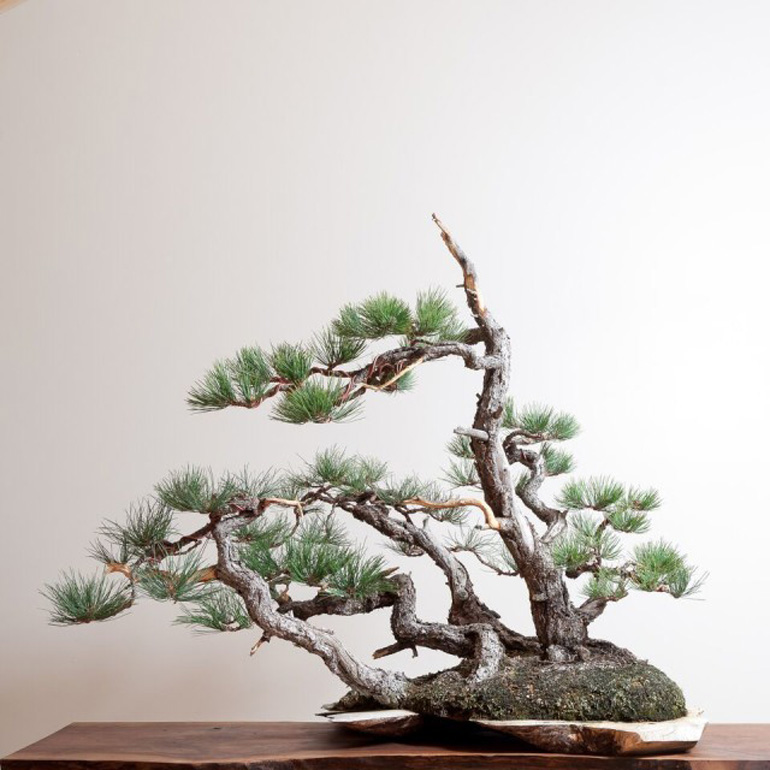
This Ponderosa pine is the lead tree on the blog and is discussed in some detail on the podcast.
Black Hills Bonsai – What You Do to the Land, You Do to Yourself
Rocky Mountain Juniper (Juniperus scopulorum) collected by Andrew (aka Andy) Smith and first styled by Walter Pall. It would hard to find a better pair for the job. Andy (Golden Arrow Bonsai) is a professional forester, master collector of wild bonsai and a bonsai artist in his own right, and Walter Pall is a world famous bonsai artist, teacher, entertainer and owner of a very impressive bonsai collection. The photograph is by Walter. My apologies for the fuzz. It's the result of dramatically increasing the image size (on balance I think this size presents a better look at the tree in spite of the fuzz).
In the air all day yesterday and now it’s a well earned West Coast vacation. So we’ll take the easy way out. This one appeared here April, 2014. It was originally from The Art of Bonsai Project blog, way back in 2005. It’s a great interview. So great that we’re going to post the whole thing and encourage you to jump in and enjoy Andy’s unique insights into wild bonsai, the art of collecting and much more.
The Art of Bonsai Project Interview with Andrew Smith
Andrew Smith is a contract forester in South Dakota’s Black Hills. He became fascinated with bonsai in 1994 while collecting core specimens from very ancient pines to use in past climate studies.
Smith transplants 300-400 trees per year for bonsai and has supplied demo and workshop trees to many of the world’s best bonsai artists. He enjoys learning about this beautiful and extraordinary art and meeting with other enthusiasts around the country.
The following is an on-line interview conducted with Andy Smith Continued below
–
Another Rocky Mountain Juniper that was collected by Andy Smith and first styled by Walter Pall. Photograph by Walter.
AoB: Andy, how do you answer the critics who insist that removing trees from a supposedly pristine environment is detrimental to that environment.
Andy: That depends upon your values and goals for the particular environment in question. For instance, most of my trees come from public lands and the permit process (in my opinion) is well regulated. I pay between $5 and $10 per tree for the right to collect in certain areas (no refunds if they die!). But there are huge areas that are off limits to collecting; for instance all wilderness areas; areas with high recreational value such as along hiking trails and near campgrounds and lakes; wildlife preserves; national monuments; state and national parks; along heavily travelled roads; areas with spiritual, historical or special visual significance; etc.
In these areas the guiding management principles place a higher value on the aesthetic, spiritual and natural qualities of the environment than they do on someone, like me, being able to go out and pursue an interest that might change the landscape somewhat.
The areas that are open to collecting are usually the same areas that are open to other resource extraction. In other words these areas might well be logged, grazed or mined at some point in time, or at least such uses are not prohibited.
Andy beside the large pine that he collected in his How to collect Wild Trees DVD.
Another thing to consider is the scale of the enterprise. I collect about 300-400 trees, from several different National Forests, every year, which is far more than anyone else I know. And it takes a huge amount of time, effort and energy to do that.
Meanwhile, the Forest Service is trying to control burn about 8,000 acres a year just here in the Black Hills alone, and many, many thousands more nationwide. This is done to reduce fuel loading and prevent catastrophic wildfires. I understand that it needs to be done but they kill more potential bonsai doing that in one year than I will collect in ten lifetimes. Consider that we recently had a wildfire here that burned over 130 square miles. The fire damage is worse than an atomic bomb would cause. It’s amazing, that in many places you can look from horizon to horizon and not see one live tree.
The forest is also constantly being thinned by chainsaw crews to reduce the overcrowding of small trees. Here again, it is work that needs to be done and thousands of acres are opened up this way every year. But hundreds of thousands of potential bonsai are destroyed in the process. I have seen a lot of areas I intended to collect in have all the bonsai cut off them because I did not return to collect the trees before a thinning crew got there. So I have to find a new place. They also sell several thousand permits to cut Christmas trees on this forest every year. A couple of times I have asked permission to collect in a certain area and been denied permission because it was in a wildlife preserve, park, etc. And then a month or two later I see they sent a thinning crew in, or control burned to reduce underbrush and all the trees I would have collected were destroyed anyway.
Another thing to consider is that nearly all the trees I collect are captives on rock outcrops. That is, they are growing in a crevice in a rock, which is what gives them their unique character. Although there are millions of acres of rocky ridges with “bonsai” on them, the actual percentage of these trees that is collectible is about 1%, or for some species, like Limber Pine (Pinus flexilis) or Rocky Mountain Juniper (Juniperus scopulorum), a far lesser percentage than that.
So, I would say that the visual impact on the landscape in most cases in virtually non-existent. Most of these fantastic looking old trees do not have a root system that is accessible, so most of them have to be left alone. It’s not like shooting all the buffalo. In this situation that is not possible. What would be possible, in an extreme situation, is that all the collectible trees could be removed from a site, but this still would not affect the environment to a large degree because we’re still only talking about the removal of the roughly 1% that is removable. However, not everyone collects off rock outcrops so this argument does not hold true in every situation.
Yet another thing to consider is that I am not collecting plants that are rare in a biological sense, and nor should be anyone else. All the species I collect are very common and grow extensively, on millions of acres across the west.
Common plants are best for bonsai anyway. The likely reason they are common is because they can tolerate a wide range of conditions. This means they might tolerate the mistakes we make in training. The trees I am looking for are rare in another sense… they are visually rare. They express some special character. It’s kind of like looking for a four leaf clover. Although clover is one of the most common and ubiquitous of lawn plants, specimens with four leaves are somewhat rare.
And one should not forget that “pristine” old Mother Nature is a very careless gardener. Millions of acres of forest are burned down every single year. A few years ago one windstorm blew down over 20,000 acres of forest on the Medicine Bow River, in Wyoming!
We have beetle infestations in our forest right now that are killing thousands of acres at a time. These are all natural processes and the forest recovers from them in greater or lesser periods of time and has been doing so since before men were around to worry about it. I think it can also recover from my collecting trips every spring.
There is a place I like to go hiking in the Black Hills. If you go off the trail there are some awesome old spruce specimens on rock outcrops. They must be several hundred years old and the trunks are just fantastic. And they would lift right out of the rock and transplant very easily and successfully. Nobody sees them because they are not right along the trail. But it’s in a wilderness area so they are off-limits. That’s fine with me. When I’m up there I just like to go and admire them, but leaving them there does not bother me a bit. It’s a special area and they are part of it.
In the same sense, collecting in areas where I am allowed seems appropriate and does not bother me either. I’m grateful that I’m allowed to make part of my living in such close contact with the outdoors and doing something that I enjoy so much.
AoB: When selecting a tree from the wild, do you already have a plan and a likely customer in mind? Do you end up inheriting those trees that aren’t already pledged “to a good home”.
Andy: The answer is: D) all of the above. I do look for specific trees for specific customers. Sometimes it takes me a couple of years to find them. I do collect trees that immediately look like great material to me, and I also collect trees that I have no idea what to do with. Those trees that seem hopeless often end up being the most fun to work with because you can try almost anything with them without the fear that you’re going to destroy a potentially “classic” bonsai if you make a mistake. One thing to remember about collecting though: You’re not really collecting a tree. You’re collecting a root system and hopefully it has something interesting attached to it. But it doesn’t matter how great t the tree is if it has no roots. (I realize that this is not true for all species. Redwoods, bald cypress and many hardwoods can be collected and rooted like big cuttings. But it’s true for all the species that grow in the dry mountains where I collect.) Anyway, my collecting is limited by what has a collectible root system. The really awesome trees are usually the ones that have survived under the harshest conditions and fewer of those are collectible. So, believe it or not, most of the really fantastic trees are more suited for a photograph than a bonsai pot.
AoB: Is there a particular species that you have better luck with collecting? If so, what species is it, and why do you believe you have better luck with them?
Andy: I’m lucky in that respect. I live in a forest that is 99% Ponderosa Pine and I think Ponderosa Pines (Pinus ponderosa) are one of the easiest conifers to collect. If I had started my bonsai hobby off by collecting limber pine I’d have probably ended up collecting vintage lawn mowers or tractors or salt and pepper sets because Limber Pine are really difficult, at least for me, to collect.
I’ve had great luck with Ponderosa Pine (Pinus ponderosa); Black Hills Spruce (Picea glauca var. ‘Densata’) ; Engelmann Spruce (Picea engelmannii); Redcurrant (Ribes triste); Rocky Mountain Juniper (Juniperus scopulorum), and Utah Juniper (Juniperus osteosperma); American Elm (Ulmus americana) and Potentilla (Potentilla sp.). I’ve had fair luck with Common Juniper (Juniperus communis); Lodgepole Pine (Pinus contorta); Sub-alpine Fir (Abies lasiocarpa); Douglas Fir (Pseudotsuga menziesii) (I have only collected a few) and Sagebrush (Artemisia sp.) I’ve had “challenging” luck on Limber Pine (Pinus flexilis); Burr Oak (Quercus macrocarpa); Quaking Aspen (Populus tremuloides) and Paper Birch (Betula papyrifera). I still haven’t had a Burr Oak live for more than two years for me, though I see some really fantastic specimens. But I haven’t given up. I’m still trying to figure them out.
AoB: What ethics do you have about collecting trees from the wild? i.e. Do you believe it is better to collect from an area that is going to be bulldozed, or from state/federal, or private land?
Continued below…
Andy: The main ethic, as Aldo Leopold put it, is not to leave the land in worse shape than it was before you got there. I try not to leave obvious visible evidence, like torn up soil, of where I have been. I also try and consider what effects my collecting will have on the landscape for other people. For instance, there is one site I found where I can collect trees, and there are some nice trees there; but it’s within view of a small lake that people like to canoe on. Because of the land ownership the site is not specifically protected. It’s tempting to go there but I haven’t. Even though I’m sure most of the canoeists don’t really look at such small trees, I would and I like to canoe. So I put a personal limit on myself that if I ever go to that particular rock outcrop I will stay on the side facing away from the lake. But I doubt I will ever go there.
Anyway, as far as ethics go, it’s really pretty simple. All of us come from and depend totally on the earth. What you do to the land you do to yourself. That doesn’t mean that you need to, or even could, cut yourself off from it. But it means you need to treat it with respect and consider what impact you are having. I’m not one of these people that thinks it’s wrong to pick a wildflower. But obviously if you have 10,000 people walking by 20 wildflowers then picking one is not a good idea.
AoB: Besides the horticultural strength needed to be collectible, what other features do you look for in a tree when collecting and do you look for the bonsai within when making the decision to collect.
Andy: Of course, every time I see a great tree I run up to it to see if it is collectible. A lot of the time it is not and I might end up taking a really mediocre tree beside it. Survivability is more important than anything else.
Collecting trees and hauling them down to the truck and then home and cleaning out the roots and potting them and applying pesticides and fertilizer and water gets to be a lot of work. If the tree dies it’s a huge waste of time, not to mention the tree. And no matter what you do some of them are going to die. But I try to collect ones I am fairly certain have a good chance to make it.
At the start of each season, almost every tree I see looks beautiful to me and I definitely collect ones that I would leave later on in the season. And if I just happened to collect ten nice literati style trees and the next one I see is a literati it will probably get left behind, no matter how nice it looks. But one thing I’ve found is that even a fairly plain tree usually improves a great deal just by being put in a pot. And if you know how to pot, and feature the shape of the tree correctly, it can really be a remarkable change. And when you add what you can do with wire to that, you start to see that you don’t always have to start with a great bonsai to end with one. And that’s the fun of it.
Andy Smith's son, Woodlin (age 6 at the time) with an enormous Juniper that was collected by Andy.
AoB: The appearance of age is of course important when selecting a tree to collect, what other visual attributes must a tree have in order to be considered for collection?
Andy: Obviously, either a thick trunk and a short height, or a tall, graceful trunk and that “dancing girl” look. The main thing is the trunk and the rootage. The foliage can usually be utilized in some way no matter how it looks to start with. But it’s hard to fake a good trunk.
When I first started this I had the “arrowhead” syndrome. When I was a kid I collected arrowheads and I’d spend hundreds of hours out in the fields looking for them. I got to be very good at picking them out, even if just a tiny edge of one was sticking through the dirt. The better I got the more broken pieces, fragments and chips I picked up. When I took friends out with me though, if they found anything they usually found a perfect arrowhead. At first I thought they were just unusually lucky but then I realized that the only kind of artefact they could recognize was one that looked like a perfect arrowhead. That’s what they pictured in their mind. When I first started collecting trees I just looked for ones that looked like my idea of a bonsai. Nowadays I realize that they all have potential, even if you can’t see it at first.
AoB: What are some differences between styling a tree that has been collected as opposed to one that has been cultivated for bonsai?
Andy: I think with a collected tree you have to follow the tree and don’t try to force it into your preconceived notions. Didn’t the “sinuous trunk” style get started just this way, from one unique collected white pine? Some of the collected trees will have a really classic bonsai inside them and some will have a very unique bonsai. But you have to, in some sense, let the tree style itself.
Trees that are commercially cultivated for bonsai have a blueprint built into them–that’s the goal of cultivation. So guess what, you have to let that tree style itself too. I guess the main difference would be that with collected trees you can really come up against something unexpected.
AoB: It is said that America has the best and biggest untapped resource of native trees for collection, do you agree with this statement and what can we do to assure that this resource remains available throughout the ages?
Andy: I don’t know if it’s true or not. What about South America? What about the mountains of India and Nepal? Or New Zealand or Australia? There’s a lot of wild places where there aren’t many people doing bonsai so I wouldn’t be sure at all that we have the world’s biggest supply of them. However, we do have quite a few. What about other planets for that matter? I wonder if extraterrestrials practice bonsai?
As far as conservation it’s all a matter of how many people want a certain resource against how much of it is out there. Right now there are not enough people interested in bonsai that it is much of a problem-at least in the areas I am aware of. The kind of collecting I do is very hard work and I don’t think huge amounts of people would ever take it up unless the price of collected trees went through the roof. But, throughout history this has happened many times with all sorts of things. If the situation came up where collected bonsai became all the rage in popular culture then conservation measures-drastic conservation measures-would probably have to be taken. But it can be done. Look at how many people like to fish and they’re still catching whoppers everyday.
AoB: The resource of Japanese wild trees available to be collected has been almost completely exhausted. Do you see signs of this starting to happen in the US?
Andy: No, not at all. Not even close. Like I mentioned earlier, we deliberately burn and cut down hundreds of thousands of potential bonsai every year. You have to look at the scale of the landscape. In the National Forest system itself there are over 193 million acres. For comparison the whole state of Pennsylvania is about 44 million acres. And this does not include The National Park system, National Monuments, BLM lands or state forest lands. And one thing I wanted to mention is that a “wild” landscape is not the only landscape that contains bonsai. I’m completely flaberggasted that someone doesn’t start a bonsai business just buying old landscaping plants and potting them. There are a zillion old planted junipers out there that are too big for the yard and they’ve already had 20 years of pruning. If I had to move into town somewhere I’d put an ad in the paper offering to buy unwanted landscaping plants. I called a landscaper in Rapid City and asked if he ever removed large, old plants and if he’d mind if I went out and dug some up. He said they removed older material all the time–usually with a chainsaw and he invited to me to go with them any day I wanted. But I never had time. I did put an ad in the Newcastle, Wyo. newspaper saying I was willing to pay money to dig up sagebrush. Sagebrush is a really interesting, beautiful plant. I got more calls than I could respond to and I never ended up having to pay anything. They were used to trying to get their kids to go out there and dig them, so if I was willing to do it for free they were happy to have me.
I read that very interesting article that was posted a year or so ago on the internet about juniper collecting in Japan. It was fascinating. People were crazy to buy these trees and collectors could get a tree and bring it into the market the same day and sell it “as is” for a fortune. A real fortune, like you could build a mansion from selling one nice tree. It was considered rude for the buyer to even try to examine the roots so the article said a lot of the trees were just sawed from the rock and the base was wrapped in burlap. They had no chance for survival. And they even did this in the middle of winter. That’s absolutely crazy. It’s amazing any of those trees survived, but enough of them did that people still wanted more. We can hope that doesn’t happen here.
On the other hand, there can be a very positive side to collecting. It gets people outdoors. It gets them involved with the environment. You have to know relatively a lot about an area to be able to find material in a place where you can collect it. You have to learn to identify local plants and know which environments they grow in, and in the process of trying to transplant them you will learn more, almost, than you wanted to know about them. I’m generally against trying to lock up areas as “pristine wilderness” where nobody can touch anything. I think people should get out into the woods and interact with it and they’ll have a greater appreciation and respect for it as a result. But, of course, it would be a bad idea to start unlimited collecting in Central Park, or somewhere where the population dwarfs the available landscape.
AoB: Do you feel that the native material available in America is comparable to what we are used to working with and do you think our native material is greatly overlooked by bonsai artists?
Andy: We certainly have some great material. I don’t know if it’s greatly overlooked or just harder to come by than nursery stock. I raise my prices a little every year. It’s not really because I want to, but because it takes a long time to realize the real costs of doing business. Making a profit is easy. Making enough of a profit to live on is tough. Anyway, collected material tends to be relatively expensive, I think. But then, on the other hand, when I go to my local nursery and see the prices of some of the medium-size potted trees there, they ain’t cheap either.
But every species has it’s stong points and weak points. Ponderosa pine is a good example. The needles tend to be too long, but the trunks are as good as any in the world. It doesn’t back bud as easily as a black pine but to compensate the branches are unbelieveably flexible. So you can create density quicker with wiring than with pinching.
Bonsai is kind of a communal project, a harmony, between man and nature. I’d much rather emphasize the trees that are in my local environment whatever their flaws may be. Not that I wouldn’t have trees from somewhere else, I certainly would, but it’s more intimate to work with the trees that grow where you are because in a way you are interacting with the local landscape. And I think that ultimately, that interacting is the most important part of the whole thing. It brings you back in touch with what is happening in the natural world.
AoB: Artistically, where do you see the bonsai in America heading and what would you say was the single most important contribution to the art in the last few years?
Andy: Well, that’s a tough one. I’m not really sure I have the perspective to answer it. There is no bonsai club within 400 miles of me and my bonsai experience is pretty isolated except for when I’m attending a show.
In America, I think bonsai is still kind of an underground art. Like a plant, it will come to the surface when the time is right for it. For now it is still developing and gaining strength.
There seems to be a lot of casual interest in bonsai, but not that many people have the time and energy to really take it up. Most of the bonsai people that I do know are like myself or even worse–they’re complete bonsai fanatics and they spend a huge amount of time, love and money on it.
Other than watering my own trees my whole exposure to bonsai is either reading magazines or going to shows. Those would have to be the biggest contributions as far as I’m concerned. You can be inspired by pictures of beautiful trees in magazines and then you can go to a show or a convention and watch the artist make another one. I remember one time, just for example, Cheryl Manning had this big San Jose Juniper (Juniperus chinensis) and it seemed confusing as could be. What could she make out of it? But she went to work and cut away the excess and carved jins and when she finished it was really breathtaking. That’s really exciting to see. And when I see that it makes me think, “Well, there’s a potential bonsai in everything.” There’s good material and there’s bad material, but there is no hopeless material.
Another thing is we’re seeing more competitions, like the Joshua Roth New Talent Competition. I think that’s fantastic. Just having a competition is an acknowledgement that we are taking it more seriously and willing to strive for excellence. It puts everything on a higher level. I’m very glad that individuals are willing to go to the time and trouble to host these bonsai conventions and competitions.
AoB: One of the most pressing issues for people collecting wild stock, anywhere, is the need to obtain approval. Just wanting to collect a tree to “save” it and make it into bonsai is usually not enough justification, for the owner to give permission. Any pointers, as to how people should approach this issue?
Andy: Offer money. Think of what the benefit to the other person is for giving the tree to you. Decide what a fair value to you really is and then offer it. If they don’t want to give permission be OK with that and look somewhere else. There is not a shortage of good trees, but you have to find them. If it takes a long time it makes them more valuable.
AoB: Development of species that are not yet popular as bonsai specimens often falls to people like you, as you are at the forefront of the collecting industry. Do you regard your role, in this respect, as important to the development of bonsai in your country?
Andy: Well, I wouldn’t say there is an industry, exactly. If there was, we’d have a union and I’d be against it. I don’t think anyone has touched the tip of the iceberg as far as American species of trees goes. For instance, I grew up in central Ohio where there are mulberry trees all over the place. This isn’t really a native, it was brought in from China. But anyway, it grows everywhere. They’ll sprout from pavement and sidewalk cracks. They flower and they have fruit and the leaves are various sizes, but I keep wondering why I never see mulberry bonsai, anywhere. The locals I’ve asked about it seem to disdain it, but none of them has really tried it. I don’t know, perhaps it’s the worst plant that ever evolved for bonsai, but still, you’d think you’d see a lousy one here and there at a show.
Anyway, I’m sure that many of the best American species for bonsai haven’t even been tried yet. I’m lucky that where I live I can find specimens of trees that are hundreds of years old and transplantable. This isn’t true everywhere and it could take many years for the real botanical gems to be discovered.
As to the last part of the question, I would say that sometimes I do fantasize that a hundred or two hundred years from now some of the trees I’ve collected will still be alive. I’m sure every bonsai collector has the same wish.
AoB: What is your survival rate for the trees you collect?
Andy: In general it is very good. Usually I get about 80-85% overall. About 95+% with ponderosa pine. Maybe only 25% on limber pine. But it can vary considerably from year to year. Last year was not very good. We had an extremely warm, dry winter. I collected a lot of trees in the early spring and they all seemed to be doing better than usual. But suddenly at the end of June and all through July we had record-breaking heat. That’s right when they usually are really pushing new roots and everything just stopped. It was a disaster. Last year my survival was only just above 50%. And although I have a theory why everything did so poorly I will never know for sure because it’s a complex set of interactions. Anyway, I had foolishly come to believe that I was expert enough at transplanting that I could make almost anything grow. And for a few years that seemed to be true. But last year reminded me that I am not the one that makes things grow.
After doing this for ten years I am more aware than ever of the harshness and unpredictability of nature. People often describe nature as fragile, but I think civilization is much more so.
Bonsai Serpent & Two Buttonwoods
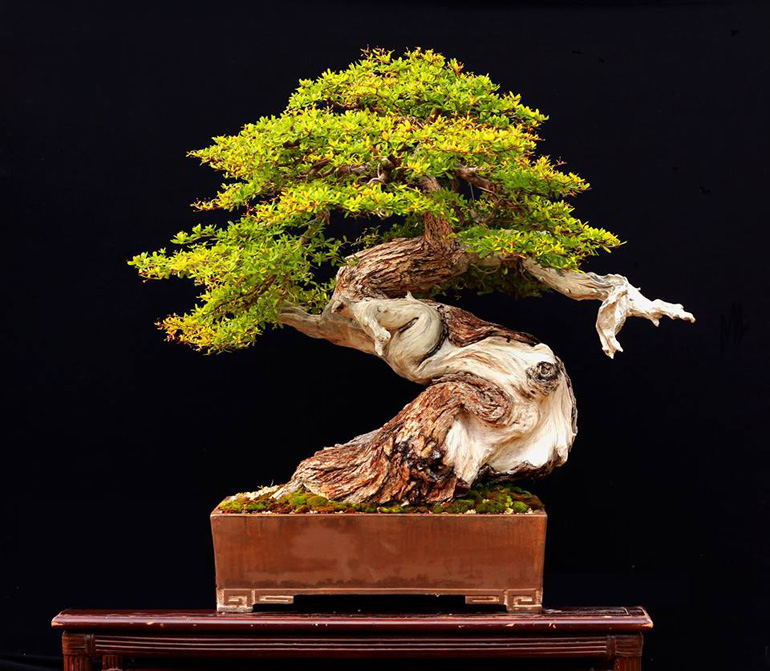
The serpent is hiding in plain sight. This magnificent tree belongs to Enrique Castaño, who has this to say about it: "This (Terminalia ucarillo) got the name Kukulcan from the Mayan mythology, Kukulcan was one of the serpents with feathers, kind of like a dragon." The more I look at this tree, the more I notice - in addition to its sheer power - how well it flows from the well chosen pot and the nicely tapered trunk to the relaxed (there's that word again - see yesterday) well balanced foliage with all the elements tying together so nicely.
Might as well stay in Mexico for another day (see yesterday). This time it’s three trees by our friend, Enrique Castaño. Enrique is from Mérida, Yucatan, Mexico. In addition to being an accomplished bonsai artist and a postdoc researcher at Harvard, Enrique is the author of Botany for Bonsai.
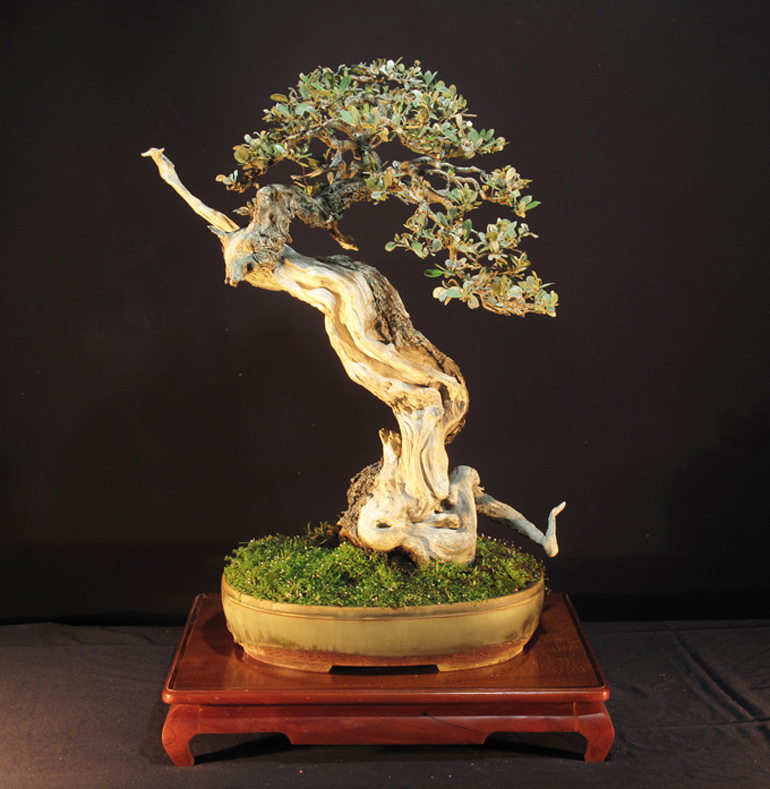
This Buttonwood is the cover tree for Enrique's Botany for Bonsai. Available at Stone Lantern.
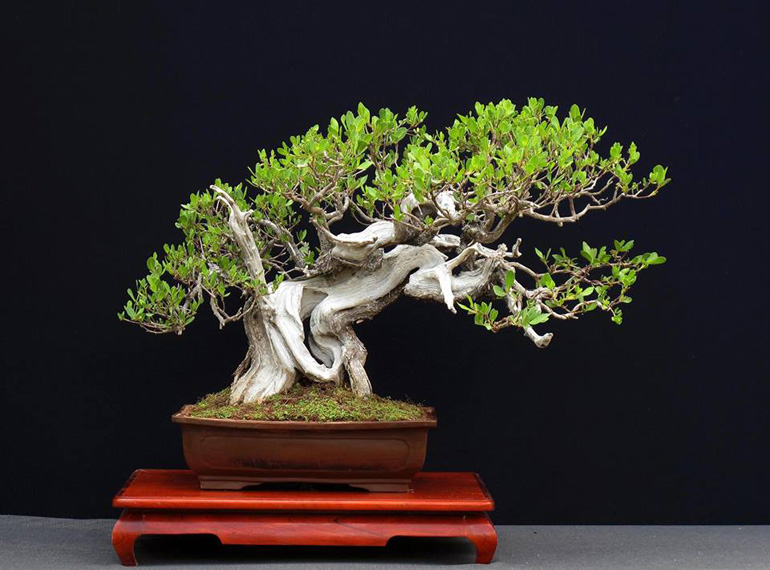
Another Buttonwood by Enrique
South of the Bonsai Border
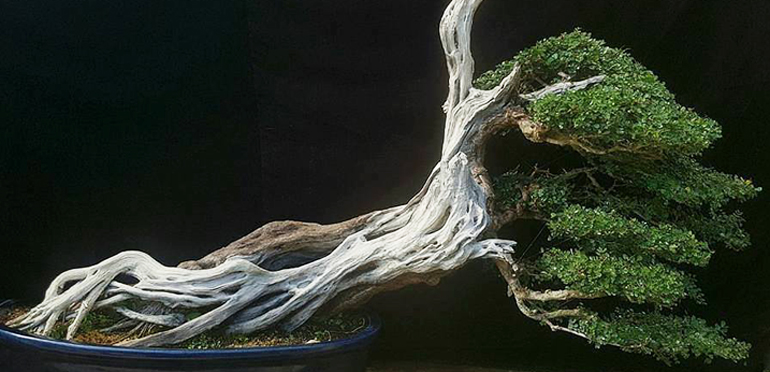
Can something be both dynamic and relaxed? Or does it even make sense to talk about a bonsai as relaxed? In any case, this unique beauty makes its home at the Museo Tatsugoro - Estudio De Bonsai Miguel Ros, Fortin, Veracruz, Mexico. In case you're wondering, what happened to the top of the photo, the answer is just below. For many more great photos where this came from, here's you link
I’ve long been fascinated with Mexico and have been visiting somewhat regularly since college years. But I’ve never been to Veracruz. Guess it’s time to put it on the agenda.
Siempre he estado fascinado con México y han estado visitando algo regularmente desde los años de colegio. Pero nunca he estado en Veracruz. Imagino que es hora de poner en el orden del día.
All of the photos shown here are borrowed from the Museo Tatsugoro – Estudio De Bonsai Miguel Ros, Fortin, Veracruz, Mexico.
–
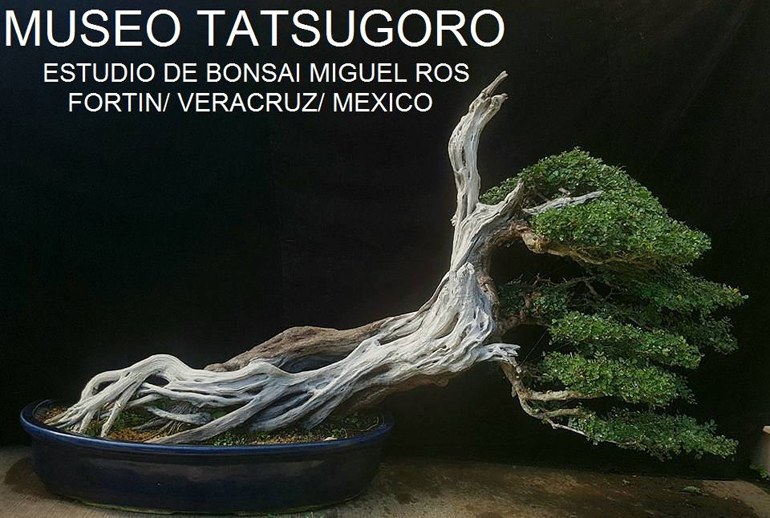
The uncropped original with this Spanish caption... Excelente mitad de semana  :) Palo de tinta. My translation (with more than a little help from Free Translantion.com) Excellent mid-week. Ink stick (is Ink stick a common name for this tree?)
:) Palo de tinta. My translation (with more than a little help from Free Translantion.com) Excellent mid-week. Ink stick (is Ink stick a common name for this tree?)
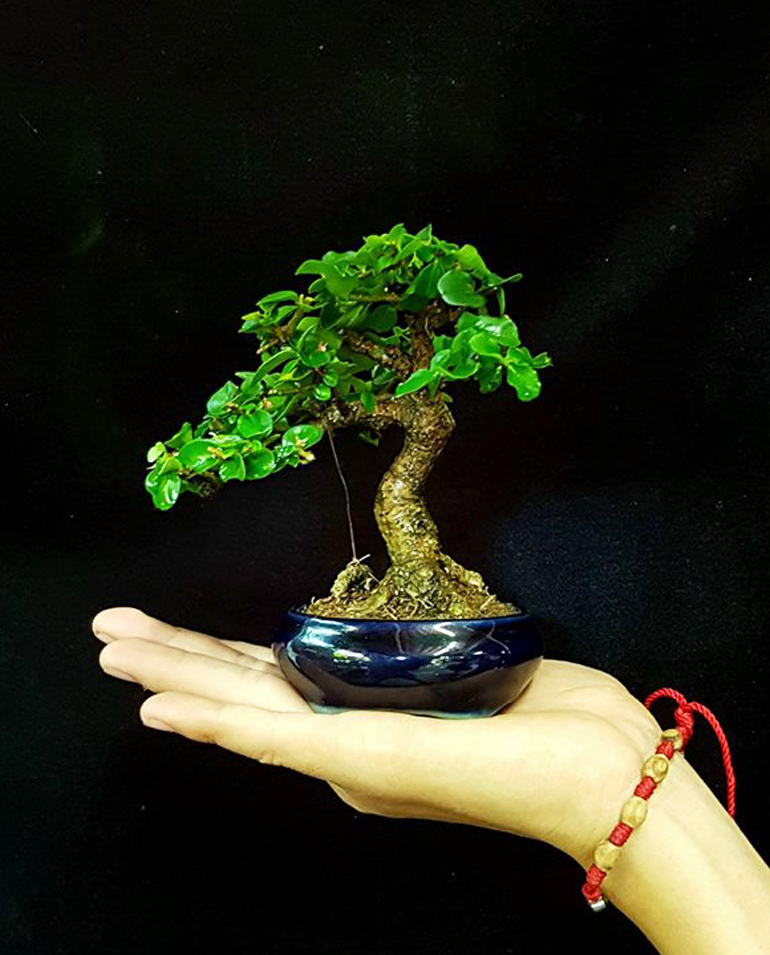
Shohin in hand. This one is identified as Ligustrum (Privet). No species is given
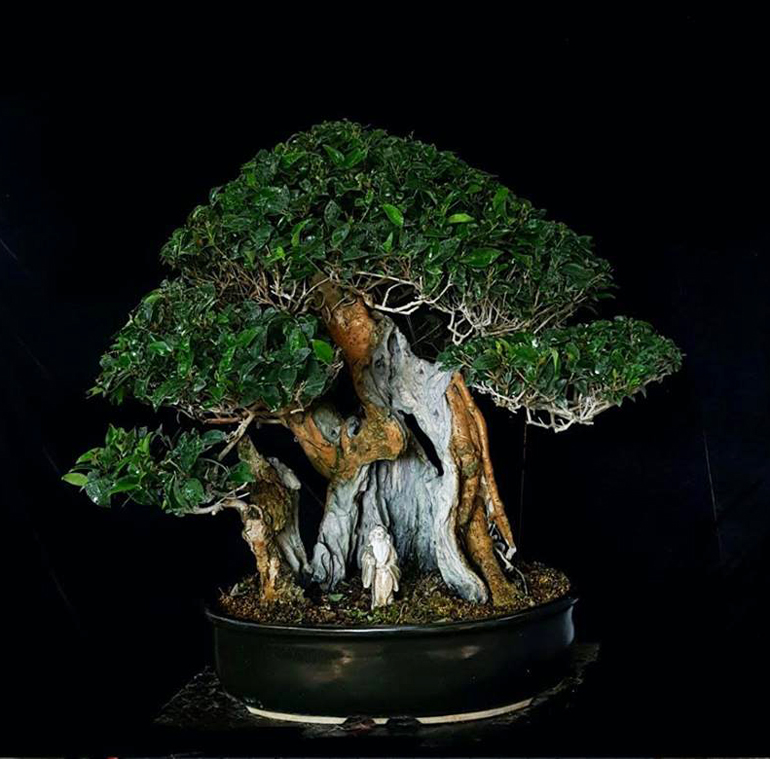
An unidentified tree with ample character. The caption reads... Excelente martes. Excellent Tuesday. Not much help
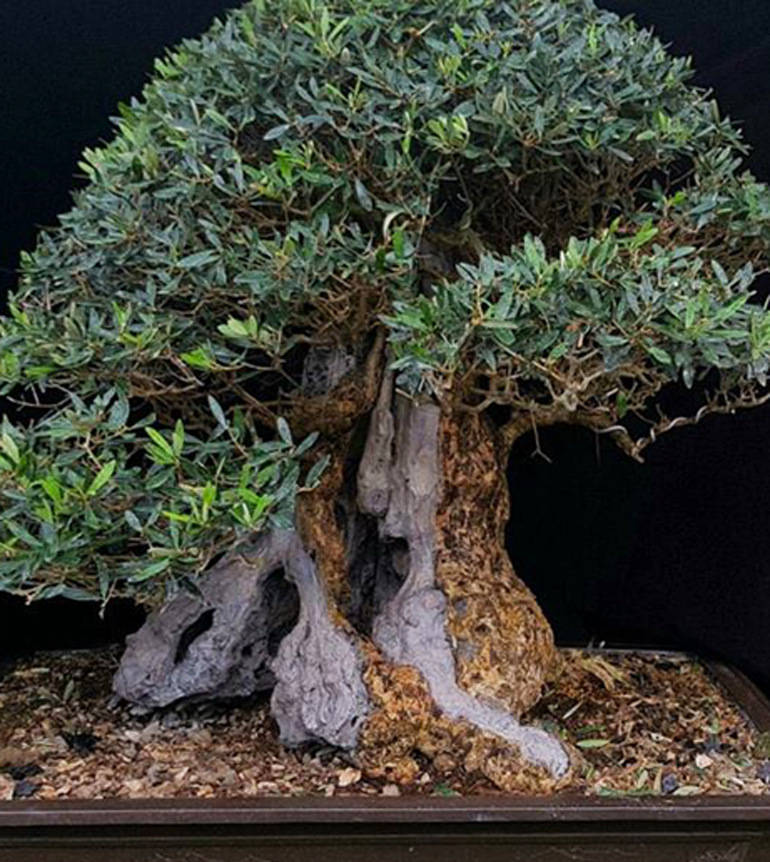
Olivo demás de 80 años. 80 year old Olive. Olives were originally brought from Spain in the early days of colonization.
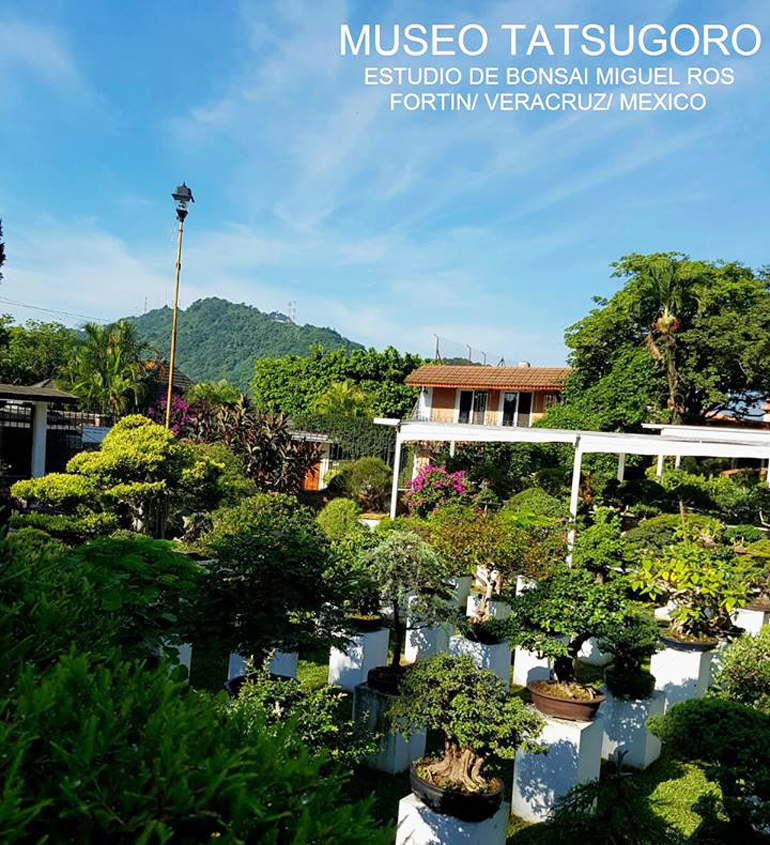
Tropical paradise
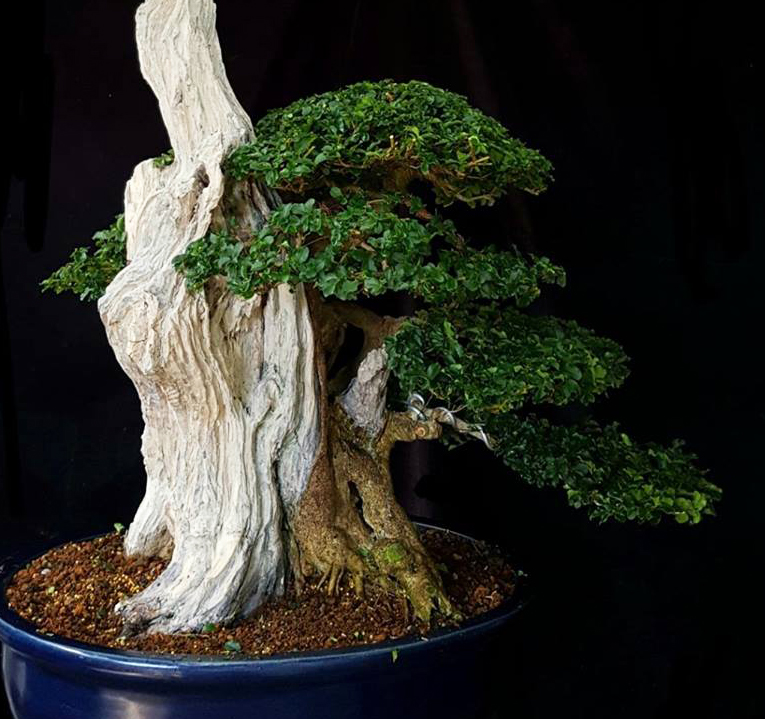
No caption with this one
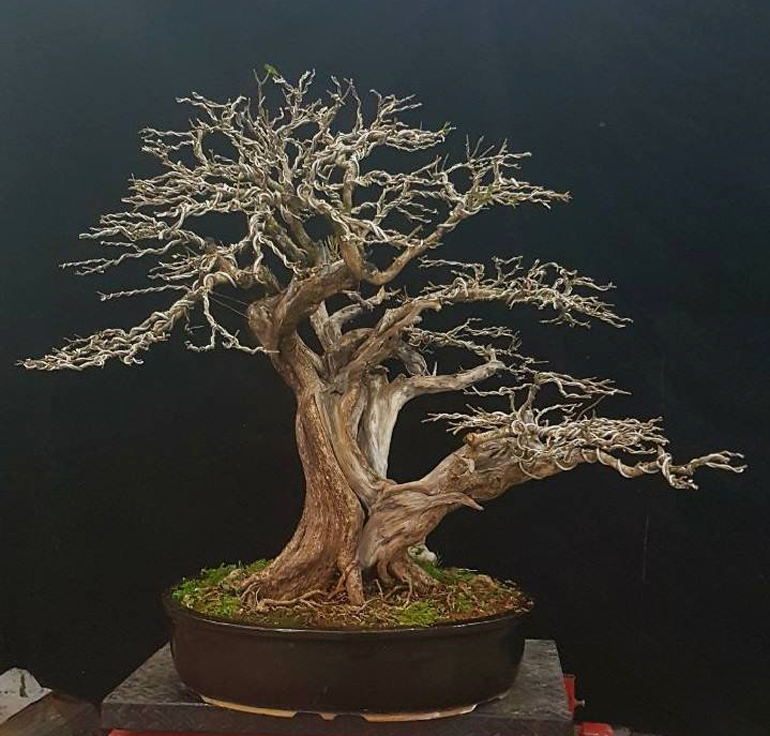
Excelente jueves  :D Mangle trabajado por Noelanders Marc. Excellent Thursday. Mangrove worked by Marc Noelanders
:D Mangle trabajado por Noelanders Marc. Excellent Thursday. Mangrove worked by Marc Noelanders
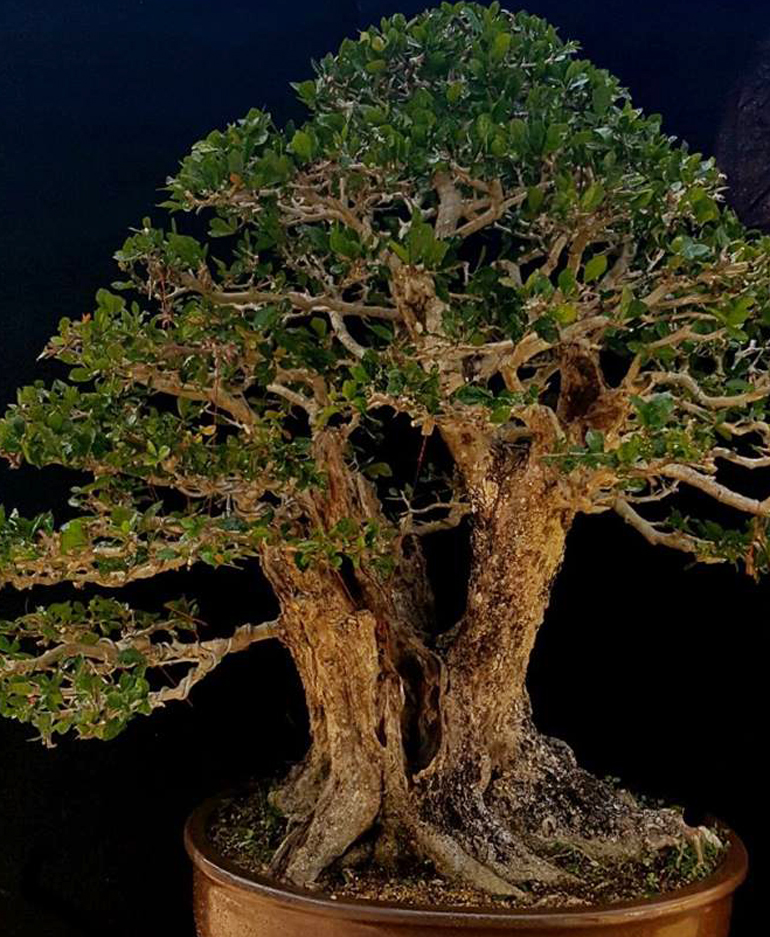
Excelente martes:) Enriquebeltrania. Excellent Tuesday. Enriquebeltrania. As you might imagine, Free Translation offered no help with Enriquebeltrania. Yusup Bonsai was tacked onto the end of the caption

